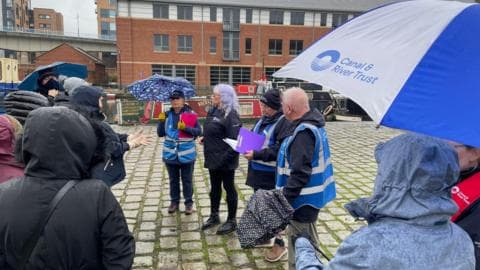
👋 Welcome to OnTheCut.net
OnTheCut is a website for boaters on the UK canal network. Providing a map of the inland waterways, notices archive, and news.
Latest News
View AllLatest news aggregated from various canal related sources.
New boats for veterans
5 January 2026 - Waterways World
Forces Veterans Afloat (FVA), the charity housing ex-servicemen who have fallen on hard times, added three new boats to its fleet in 2025. First there was Stingray, a 41ft …

Canal collapse repairs to take most of 2026
4 January 2026 - BBC News
New aerial footage shows the extent of the damage on the canal in Shropshire.

'Storm-battered' canals need more volunteers
3 January 2026 - BBC News
The Canal & River Trust appeals for volunteers to come forward to look after canals in Yorkshire.

KING’S AWARD for Voluntary Service Honours Grantham RiverCare for Protecting the River Witham
3 January 2026 - Towpath Talk
Grantham RiverCare has been recognised with the King’s Award for Voluntary Service, the highest accolade a voluntary group can receive ...
Latest Vlogs
View AllA collection of vlogs from the UK canal network.

The end and the beginning | Fulltime Narrowboat life #boatlife #narrowboat #canal
4 January 2026 - Art in the corridor
Welcome back to Art in the Corridor (ep.100) Welcome back to Art in the Corridor. This last week we have sad goodbye to 2025 and start 2026 in all its...

Narrowboater's Mixed Year! Review of 2025. What is Instore for the Boat with a Poorly Engine? No201
4 January 2026 - Narrowboat Natterings
The Lumsdens are having a bit of a natter about their year as leisure Narrowboaters in 2025. Some of this nattering is done whilst Lumpy cooks a Paneer and Spinach...

Steam Train Brakes Explained Vacuum, Steam & Handbrake on the Chasewater Railway
4 January 2026 - Court Above The Cut
Buy me a coffee! - https://ko-fi.com/courtabovethecut Patreon - patreon.com/CourtIndustrialHistory Court Exploring - https://www.youtube.com/@CourtExploring @CourtExploring Please Sponsor me Here for my Walk 1,000 Miles Challenge for the @wiltsberkscanaltrust https://www.justgiving.com/page/stephen-court-1707940484073 Join this...

Ancient Lock Secrets Revealed Historical Engineering Masterpiece! on the Wilts and Berks Canal
4 January 2026 - Court Above The Cut
Buy me a coffee! - https://ko-fi.com/courtabovethecut Patreon - patreon.com/CourtIndustrialHistory Court Exploring - https://www.youtube.com/@CourtExploring @CourtExploring Please Sponsor me Here for my Walk 1,000 Miles Challenge for the @wiltsberkscanaltrust https://www.justgiving.com/page/stephen-court-1707940484073 Join this...